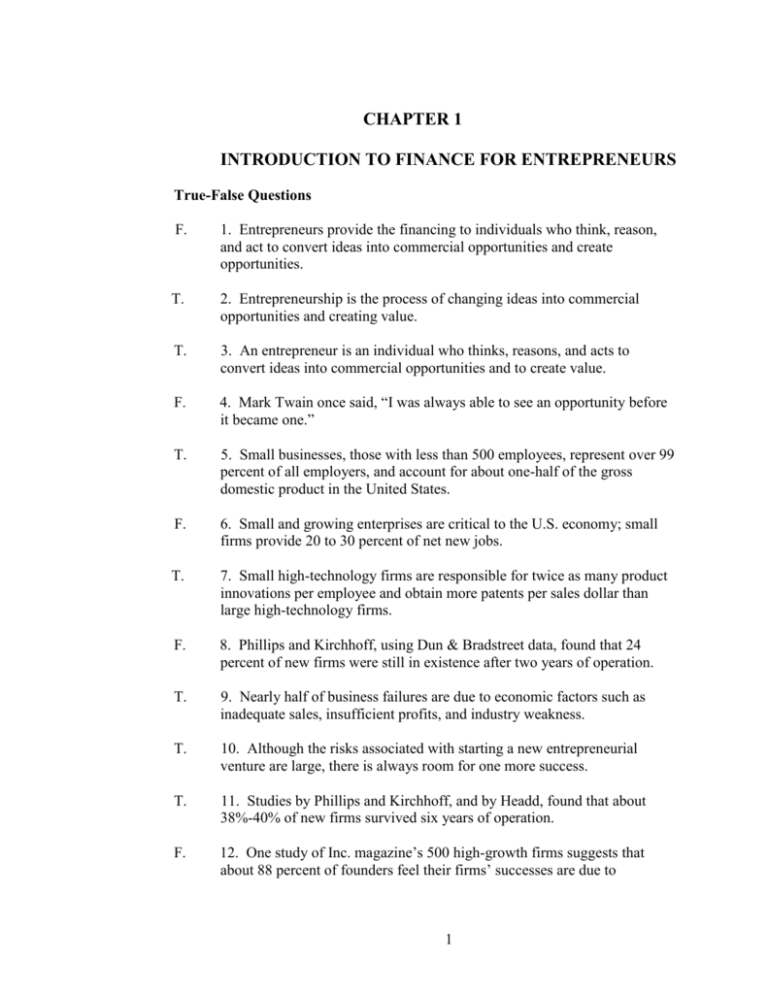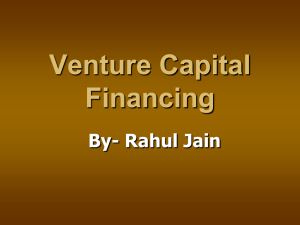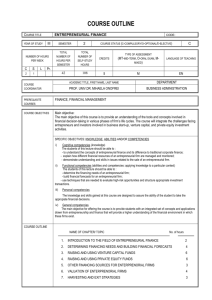CHAPTER 1 - Test Bank
advertisement

CHAPTER 1 INTRODUCTION TO FINANCE FOR ENTREPRENEURS True-False Questions F. 1. Entrepreneurs provide the financing to individuals who think, reason, and act to convert ideas into commercial opportunities and create opportunities. T. 2. Entrepreneurship is the process of changing ideas into commercial opportunities and creating value. T. 3. An entrepreneur is an individual who thinks, reasons, and acts to convert ideas into commercial opportunities and to create value. F. 4. Mark Twain once said, “I was always able to see an opportunity before it became one.” T. 5. Small businesses, those with less than 500 employees, represent over 99 percent of all employers, and account for about one-half of the gross domestic product in the United States. F. 6. Small and growing enterprises are critical to the U.S. economy; small firms provide 20 to 30 percent of net new jobs. T. 7. Small high-technology firms are responsible for twice as many product innovations per employee and obtain more patents per sales dollar than large high-technology firms. F. 8. Phillips and Kirchhoff, using Dun & Bradstreet data, found that 24 percent of new firms were still in existence after two years of operation. T. 9. Nearly half of business failures are due to economic factors such as inadequate sales, insufficient profits, and industry weakness. T. 10. Although the risks associated with starting a new entrepreneurial venture are large, there is always room for one more success. T. 11. Studies by Phillips and Kirchhoff, and by Headd, found that about 38%-40% of new firms survived six years of operation. F. 12. One study of Inc. magazine’s 500 high-growth firms suggests that about 88 percent of founders feel their firms’ successes are due to 1 2 Chapter 1: Introduction to Finance for Entrepreneurs extraordinary ideas, while the remaining 12 percent feel their firms’ successes are due to exceptional execution of ordinary ideas. F. 13. “Fads” are large societal, demographic, or technological trends or changes that are slow in forming but once in place continue for many years. T. 14. “Fads” are not predictable, have short lives, and do not involve macro changes. T. 15. Three major megatrends discussed in Chapter 1 include: societal trends or changes, demographic trends or changes, and technological trends or changes. F. 16. In 1982, Harry Dent identified several major or megatrends shaping U.S. society and the world. T. 17. The so-called “baby boom” generation applies to people born in the United States during the 1946-1964 time period. T. 18. Perhaps the most important invention shuttling us from an industrial society to an information society is the computer chip. F. 19. Environmental commerce, or e-commerce, involves the use of electronic means to conduct business online. T. 20. The Office of Advocacy of the U.S. Small Business Administration documents that “employer firm births” have exceeded 700,000 annually in recent years. F. 21. Reasonable estimates place nonemployer (e.g., single person or small family) business started each year at less than 100,000. F. 22. Bill Gates once said: “I was seldom able to see an opportunity, until it ceased to be one.” T. 23. A study by Phillips and Kirchhoff using Dun & Bradstreet data found that about three-fourths of new firms were still in existence after two years of operation. T. 24. Studies by Phillips and Kirchhoff, and by Headd, found that one-half of new firms or new employers were still in existence after four years of operation. F. 25. Nine principles of entrepreneurial finance are identified and explored in this entrepreneurial finance textbook, Chapter 1: Introduction to Finance for Entrepreneurs 3 T. 26. The “time value of money” is an important component of the rent one pays for using someone else’s financial capital. F. 27. A venture’s financial objective is to survive. F. 28. Private financial markets are a place where standardized contracts or securities are traded on organized security exchanges with restrictions on how they can be transferred. F. 29. Free cash flow is the net income forecast to be available to the venture’s owners over time. T. 30. Free cash flows are adjusted for risk and the time value of money when used to calculate the value of a venture. T. 31. Free cash exists when cash exceeds that which is needed to operate, pay creditors, and invest in assets. F. 32. Free cash is all the cash available to cover operating expenses. T. 33. Owner-manager (agency) conflicts are differences between manager’s self-interest and that of the owners who hired the manager. F. 34. The owner-debtholder conflict is the divergence of the owners’ and lenders’ self-interest as the firm gets close to going “public.” F. 35. The financial objective of increasing value is inconsistent with developing positive character and reputation. T. 36. Entrepreneurial finance is the application and adaptation of financial tools and techniques to the planning, funding, operations, and valuation of an entrepreneurial venture. F. 37. Financial distress occurs when cash flow is insufficient to meet current debt obligations. T. 38. The second stage in a successful venture’s life cycle is the startup stage. F. 39. The rapid growth stage directly follows the startup stage. T. 40. Early-stage ventures include firms in their development, startup, or survival live cycle stages. 4 Chapter 1: Introduction to Finance for Entrepreneurs T. 41. Business angels are wealthy individuals acting as informal or private investors, who provide venture financing for small businesses. F. 42. Mezzanine financing is temporary financing needed to keep the venture afloat until the next offering. T. 43. “Crises and bubbles” and “emerging economies and global change” are considered to be sources of entrepreneurial opportunities. T. 44. In Chapter I five mega-trend categories are identified as sources of entrepreneurial opportunities. F. 45. Entrepreneurial opportunities can occur only when there are societal changes in the world. T. 46. One principal of entrepreneurial finance is “risk and expected reward go hand in hand. F. 47. While cash is the language of business, accounting is the currency. T. 48. Venture character and reputation can be assets or liabilities. Multiple-Choice Questions e. 1. Successful entrepreneurs exhibit which of the following traits? a. recognize and seize commercial opportunities b. economic pessimism c. tend to be doggedly optimistic d. both a and b e. both a and c c. 2. While one must be careful to avoid too many generalizations about entrepreneurial traits or characteristics, which one of the following characteristics would not normally be associated with successful entrepreneurs? a. being able to see and seize a commercial opportunity b. planning for the venture’s future c. only being able to see an opportunity after it ceases to be one d. being optimistic about the venture’s success b. 3. About one-half of all newly created businesses in the U.S. are dissolved or cease operations within how many years after being started? a. two years b. four years Chapter 1: Introduction to Finance for Entrepreneurs 5 c. six years d. eight years c. 4. About 60 percent of all newly created businesses in the U.S. are dissolved or cease operations within how many years after being started? a. two years b. four years c. six years d. eight years d. 5. “Fads” are: a. not predictable b. have short lives c. do not involve macro changes d. all of the above c. 6. Harry Dent documented major generation waves in the United during the twentieth century in: a. 1972 b. 1982 c. 1993 d. 2003 b. 7. “E-commerce” refers to: a. environmental commerce b. electronic commerce c. economic commerce d. exploratory commerce f. 8. While entrepreneurial opportunities come from an almost unlimited number of sources, this textbook focuses on: a. societal changes b. demographic changes c. technological changes d. crises and bubbles e. emerging economies and global changes f. all of the above d. States 9. Indicate the number of principles of entrepreneurial finance that are emphasized in this textbook: a. one b. three c. five d. seven e. nine 6 Chapter 1: Introduction to Finance for Entrepreneurs e. 10. Maximizing the value of the venture to its owners is the common financial goal of which of the following? a. the entrepreneur b. the debtholders c. the venture equity investors d. both a and b e. both a and c a. 11. Which of the following is considered to be an “agency” conflict? a. owner-manager conflict b. stockholder-manager conflict c. stockholder-debtholder conflict d. manager-debtholder conflict a. 12. Which one of the following possible conflicts of interest is usually minimized through the use of equity incentives? a. owner-manager conflicts b. owner-employee conflicts c. manager-employee conflicts d. manager-debtholder conflicts d. 13. Which one of the following possible conflicts of interest increases in divergence at venture gets close to bankruptcy? a. owner-manager conflict b. owner-employee conflict c. manager-employee conflict d. manager-debtholder conflict d. 14. Which of the following is not a life cycle stage of a successful venture? a. development stage b. startup stage c. survival stage d. cash cow stage e. early-maturity stage c. 15. Which of the following does not describe activity during the venture’s life cycle startup stage? a. venture’s organization b. venture’s development c. operating cash flows are generated d. initial revenue model is put in place Chapter 1: Introduction to Finance for Entrepreneurs 7 a. 16. At which stage of the venture’s life cycle stage is best characterized by the period when revenues start to grow and when cash flows from operations begin covering cash outflows? a. survival stage b. startup stage c. rapid growth stage d. early-maturity stage b. 17. Which is not a major source of start-up financing for a venture’s startup stage? a. entrepreneur’s assets b. business operations c. family and friends d. business angels e. venture capitalists d. 18. Obtaining bank loan, issuing bonds, and issuing stock is characteristic of which type of financing during the venture’s life cycle? a. seed financing b. second round financing c. mezzanine financing d. seasoned financing e. liquidity stage financing c. 19. During a venture’s rapid growth stage, funds for plant expansion, marketing expenditures, working capital, and product or service improvements is obtained through? a. seed financing b. second round financing c. mezzanine financing d. seasoned financing e. liquidity stage financing b. 20. Founder and venture investor shares are sold to the public after the initial offering to the public is called? a. secondary market transaction b. secondary stock offering c. venture offering d. bridge loan d. 21. Which of the following advise and assist corporations on the type, timing, and costs of issuing new debt and equity securities and facilitate the sale of firms? a. brokerage firms b. venture law firms 8 Chapter 1: Introduction to Finance for Entrepreneurs c. specialist firms d. investment banking firms c. 22. Which stage in the venture life cycle is characterized by creating and building value, obtaining additional financing, and examining opportunities? a. survival stage b. startup stage c. rapid growth stage d. early-maturity stage b. 23. Which of these statements is correct? a. The development stage occurs between the startup and survival stages of a venture’s life cycle b. The early-maturity stage is the final stage of a new venture’s lifecycle c. Firms typically begin to cover all expenses with internallygenerated funds during the survival stage d. During the startup stage, revenues grow much more rapidly than cash expenditures e. None of the above c. 24. The last three stages of a successful venture’s life cycle occur in the following order: a. startup, development, rapid growth b. startup, survival, rapid growth c. survival, rapid growth, early-maturity d. development, startup, survival e. 25. The stage that precedes the middle stage in a successful venture’s life cycle is called the: a. rapid growth stage b. early-maturity stage c. development stage d. survival stage e. startup stage e. 26. During the maturity stage of a venture’s life cycle, the primary source of funds is in the form of: a. mezzanine financing b. seed financing c. startup financing d. first round financing e. seasoned financing a. 27. The type of financing that occurs during the development stage of a venture’s life cycle is typically referred to as: Chapter 1: Introduction to Finance for Entrepreneurs a. b. c. d. e. d. 9 seed financing startup financing first round financing second round financing mezzanine financing 28. Mezzanine financing is associated with which one of the following life cycle stages: a. development stage b. startup stage c. survival stage d. rapid growth stage e. early-maturity stage f. 29. Entrepreneurial finance is the application and adaptation of financial tools and techniques to an entrepreneurial venture. Entrepreneurial finance involves: a. planning b. funding c. operations d. valuation e. a and d above f. all of the above e. 30. The first three stages of a successful venture’s life cycle occur in the following order: a. development, rapid growth, survival b. startup, development, rapid growth c. startup, survival, rapid growth d. survival, rapid growth, early-maturity e. development, startup, survival b. 31. The last stage in a successful venture’s life cycle is called the: a. rapid growth stage b. early-maturity stage c. development stage d. survival stage e. startup stage c. 32. The type of financing that occurs during the survival stage of a venture’s life cycle is typically referred to as the: a. seed financing b. startup financing c. first round financing d. second round financing 10 Chapter 1: Introduction to Finance for Entrepreneurs e. mezzanine financing e. 33. Which one of the following would not be considered a type of venture financing? a. seed financing b. startup financing c. mezzanine financing d. liquidity-stage financing e. seasoned financing b. 34. One study of successful entrepreneurs indicated that a majority felt that the most important factor in the long-term success of their ventures was: a. being greedy b. having high ethical standards c. working hard d. taking frequent vacations a. 35. Financial markets where customized contracts or securities are negotiated, created, and held with restrictions on how they can be transferred are called: a. private financial markets b. public financial markets c. domestic financial markets d. international financial markets e. all of the above a. 36. The time value of money concept is associated with which one of the following principles of entrepreneurial finance: a. real, human, and financial capital must be rented from owners b. risk and expected reward go hand in hand c. while accounting is the language of business, cash is the currency d. it is dangerous to assume that people act against their own selfinterests d. 37. The goal of the entrepreneurial process is to: a. develop opportunities b. gather resources c. manage and build operations d. create value c. 38. Which of the following is not considered to be a mega-trend in this textbook? a. societal, demographic, and technological changes b. crises and bubbles Chapter 1: Introduction to Finance for Entrepreneurs 11 c. fads d. emerging economies and global changes Supplementary Questions (may require basic knowledge of probability and/or prior introductory accounting and business concepts) c. 1. You have the opportunity of making a $5,000 investment. The outcomes one year from now will be either $4,500 or $6,000 with an equal chance of either outcome occurring. What is the expected outcome? a. $4,500 b. $6,000 c. $5,250 d. $5,750 e. $5,000 a. 2. You have the opportunity of making a $5,000 investment. The outcomes one year from now will be either $5,000 or $6,000 with an equal chance of either outcome occurring. What is the expected rate of return? a. 10% b. 15% c. 20% d. 25% e. 30% c. 3. A project requires an initial investment of $1,000,000. In one year, there is a 40% chance of a $950,000 return; a 50% chance of a $1,200,000 return; and a 10% chance of a $2,000,000 return. What is the project’s expected return one year from now? a. 12.8% b. 15.5% c. 18.0% d. 38.3% a. 4. Lindsey and Tobias have the opportunity to invest in a project that requires an investment of $3,000. There is a 35% chance of a $2,900 return; a 40% chance of a $3,400 return; and a 25% chance of a $4,500 return one year from now. Lindsey requires a 15% return on the project after the first year, but Tobias requires a return of only 12%. Using the expected rate of return: a. Lindsey and Tobias should both invest in the project b. Only Tobias should invest in the project c. Only Lindsey should invest in the project d. Lindsey and Tobias should both reject the project 12 Chapter 1: Introduction to Finance for Entrepreneurs b. 5. You are considering investing in two independent projects “A” and “B”. Project A requires an initial investment of $12,000. In one year, there is a 30% chance of a $10,500 return; a 50% chance of a $12,500 return; and a 20% chance of a $14,500 return. Project B requires an initial investment of $1,000. In one year, there is a 25% chance of a $950 return; a 25% chance of a $1,000 return; and a 50% chance of a $1,200 return. If you require a 7% return on your investment after one year, you should: a. Accept A and reject B b. Accept B and reject A c. Accept both projects d. Reject both projects c. 6. Assume that you can sell a new product at $5.00 per unit. Your variable costs are $3.00 per unit and you fixed costs are $20,000. What is your breakeven point in sales units? a. 5,000 b. 7,500 c. 10,000 d. 12,500 e. 15,000 d. 7. Assume that you can sell a new product at $5.00 per unit. Your variable costs are $3.00 per unit and you fixed costs are $20,000. What will be your profit before taxes if you sell 12,000 units next year? a. $0 b. $1,000 c. $2,000 d. $4,000 e. $8,000






